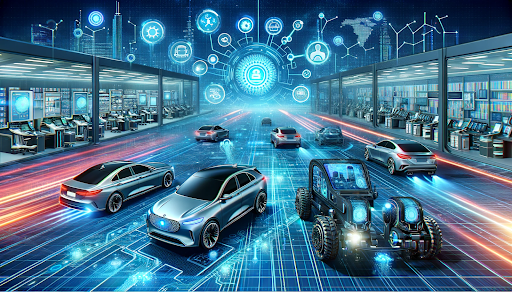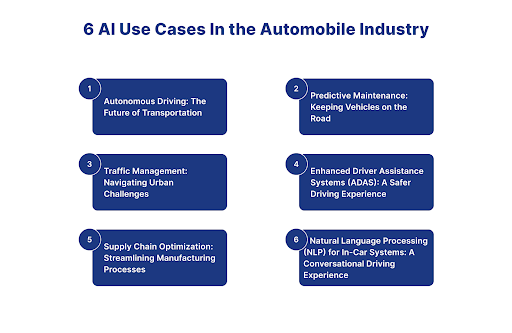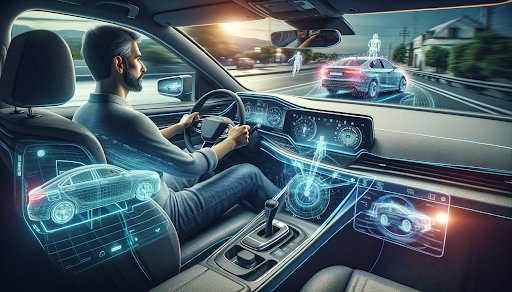AI Use Cases In The Automobile Industry: Exploring 6 AI Use Cases in the Automobile Industry
Posted by Hitul Mistry
/12 Jan 23
Tagged under: #ai,#aiusecases,#automobileindustry
This blog will rigorously investigate many significant AI use cases in the automobile industry, supported by real-life examples demonstrating this technological revolution's breadth and depth.
Introduction

-
With the incorporation of AI, the vehicle industry, a cornerstone of contemporary transportation, is undergoing a seismic transformation. This union of technology and transportation is about more than just making automobiles smarter; it is about altering the overall driving experience. This blog will rigorously investigate many significant AI use cases in the automobile industry, supported by real-life examples demonstrating this technological revolution's breadth and depth.
6 AI Use Cases In the Automobile Industry

1.Autonomous Driving: The Future of Transportation
- Autonomous driving is a game-changing advancement in transportation, with cars outfitted with advanced technology to navigate and function without human involvement. The combination of AI, machine learning algorithms, and a vast array of sensors, cameras, and radars that constitute the backbone of autonomous vehicle systems is at the heart of this dramatic transition.
I.Key Components of Autonomous Driving:
-
Sensor Fusion: Autonomous cars are outfitted with many sensors, including lidar, radar, cameras, and ultrasonic sensors. These sensors work together to provide a complete and real-time awareness of the vehicle's surrounding.
-
Machine Learning Algorithms: AI-powered machine learning algorithms comprehend the massive amounts of data sensors collect. These algorithms let the car distinguish objects, pedestrians, road signs, and other critical environmental features.
Real-Life Example: Tesla's Autopilot System
- Tesla's Autopilot technology is a tribute to the improvements in autonomous driving. Tesla vehicles can drive, change lanes, and react to traffic conditions independently, thanks to a mix of AI algorithms and sensors. The system continually learns from real-world data, making each Tesla on the road contribute to the collective intelligence that refines and improves the overall autonomous driving experience. This can be an AI use cases in the automobile industry.
2.Predictive Maintenance: Keeping Vehicles on the Road
- Predictive maintenance is a proactive approach to vehicle maintenance that uses data analytics, machine learning, and Artificial Intelligence (AI) to forecast when vehicle components are likely to fail. Predictive maintenance systems seek to discover faults before they develop into costly and disruptive breakdowns by evaluating real-time data from multiple sensors and monitoring the vehicle's overall health. This innovative strategy maintains vehicle dependability, leading to excellent safety, decreased downtime, and significant cost savings.
I.Components of Predictive Maintenance::
-
Sensor Data: Modern automobiles are outfitted with various sensors that monitor numerous characteristics such as engine performance, temperature, pressure, and vibration. These sensors continually gather data, giving a real-time picture of the vehicle's state.
-
Machine Learning Algorithms: Using machine learning algorithms is at the heart of predictive maintenance. These algorithms examine previous data, find trends, and forecast the future health of vehicle components. As more data is collected, the computers' predictions grow more accurate.
Real-Life Example: General Motors' Predictive Maintenance:
- General Motors (GM) has used predictive maintenance in its production units. Utilizing AI algorithms, GM can forecast when machines and equipment on the assembly line will likely fail. This enables the organization to arrange repair during planned downtime, decreasing the impact on production schedules and lowering the possibility of unexpected breakdowns. This can be an AI use cases in the automobile industry.
3.Traffic Management: Navigating Urban Challenges
- Globally, urban regions face the dilemma of traffic congestion, which leads to longer travel times, more significant air pollution, and a lower overall quality of life for people. Traffic management, enhanced by the use of AI, has emerged as a powerful tool for navigating and mitigating the difficulties of urban traffic. AI-powered traffic management systems aim to improve urban transportation's efficiency, safety, and sustainability by optimizing signal timings and giving real-time traffic analytics.
I.Components of AI-Driven Traffic Management:
-
Real-Time Data Collection: AI-powered traffic management systems rely on real-time data collected from various sources, including traffic cameras, sensors embedded in roadways, GPS devices in vehicles, and even social media feeds. This data gives a dynamic and thorough insight into current traffic conditions.
-
Machine Learning Algorithms: Machine learning algorithms examine massive volumes of data to find trends, estimate traffic flow, and anticipate congestion. These algorithms adapt and learn from prior data, increasing their accuracy.
Real-Life Example: Singapore's Urban Traffic Management and Control (UTMC):
- Singapore's UTMC is a pioneering example of AI-driven traffic control. The system uses data from a network of sensors and cameras across the city to monitor and evaluate traffic conditions in real-time. AI systems dynamically alter traffic signal timings, control congestion, and give real-time traffic information to both authorities and commuters, contributing to a more efficient and sustainable urban transportation environment. Singapore's UTMC is a pioneering example of AI-driven traffic control. The system uses data from a network of sensors and cameras across the city to monitor and evaluate traffic conditions in real time. AI systems dynamically alter traffic signal timings, control congestion, and give real-time traffic information to both authorities and commuters, contributing to a more efficient and sustainable urban transportation environment. This can be an AI use cases in the automobile industry.
4.Enhanced Driver Assistance Systems (ADAS): A Safer Driving Experience

Critical Components of Enhanced ADAS:
-
Collision Avoidance Systems: ADAS incorporates sensors such as radar and cameras to monitor the vehicle's surroundings. In the event of an impending accident, the system can alert the driver and, in certain situations, take autonomous action to avoid or lessen the impact.
-
Lane Departure Warning and Lane-Keeping Assist: Cameras and sensors monitor the vehicle's position within its lane. If the system detects an inadvertent lane deviation, it will warn the driver and may assist by directing the car back into the lane.
Real-Life Example: Tesla's Full Self-Driving (FSD) Package:
- Tesla's Full Self-Driving (FSD) package is an excellent example of a sophisticated ADAS system. While "Full Self-Driving" may seem romantic, Tesla vehicles equipped with FSD include technologies such as Autopilot, which provides sophisticated driver-aid capabilities. This includes adaptive cruise control, lane-keeping assistance, automated lane changes, and the capacity to travel highways autonomously. Tesla constantly changes its software, providing new features and enhancements based on real-world data from its fleet. This can be an AI use cases in the automobile industry.
5.Supply Chain Optimization: Streamlining Manufacturing Processes
- Supply chain Optimization, powered by AI, is reshaping the industrial environment by increasing efficiency, lowering costs, and boosting overall operational performance. This method entails using AI algorithms, data analytics, and intelligent technology to simplify every aspect of the industrial supply chain, from procurement and production to distribution and logistics. The objective is to develop a more agile, responsive, cost-effective manufacturing environment.
I.Key Supply Chain Optimization Components:
-
Predictive Analytics: AI algorithms examine historical and real-time data to forecast demand trends, allowing producers to anticipate swings in demand and modify production schedules appropriately. This eliminates the possibility of overproduction or stockouts.
-
Inventory Management: AI-powered inventory management systems optimize stock levels by considering lead times, demand forecasts, and manufacturing capacity. This guarantees that the appropriate amount of goods is always accessible, reducing carrying costs and eliminating stockouts.
Real-Life Example: Ford's Use of AI in Manufacturing: :
- Ford has integrated artificial intelligence into its manufacturing processes to improve production efficiency. AI algorithms evaluate data from sensors and production lines to identify bottlenecks, forecast equipment maintenance needs, and simplify the manufacturing workflow. This has resulted in higher production, less downtime, as well as a more nimble reaction to changing market conditions needs. This can be an AI use cases in the automobile industry.
6.Natural Language Processing (NLP) for In-Car Systems: A Conversational Driving Experience
- Incorporating Natural Language Processing (NLP) into in-car technologies represents a considerable advancement in human-vehicle interaction, converting the driving experience into a more intuitive, hands-free, and conversational voyage. NLP, a subtype of Artificial Intelligence (AI), enables automobiles to interpret and respond to human language. It allows drivers to engage with their vehicles via voice commands and get real-time information, entertainment, and support. This improves convenience and adds to safer driving by reducing distractions.
I.Components of NLP in In-Car Systems:
-
Speech Recognition: NLP employs powerful voice recognition technology to accurately transcribe spoken words into text. This allows the car's technology to understand and interpret the driver's orders.
-
Natural Language Understanding (NLU) NLP systems go beyond essential recognition; they use NLU to grasp the context and meaning of spoken words. This enables more advanced interactions and directives, making communication between the driver and the automobile more natural.
Real-Life Example: Mercedes-Benz MBUX System:
- Mercedes-Benz's MBUX (Mercedes-Benz User Experience) system is a prime example of NLP in in-car technology. The MBUX system has a highly powerful speech recognition technology that interprets natural language instructions. Drivers may activate the system by saying "Hey Mercedes" and then give instructions or ask queries ranging from altering cabin settings to acquiring information about the weather or local sites of interest. This can be an AI use cases in the automobile industry.
Conclusion
- Incorporating AI into the car industry is more than a technology advancement; it is a paradigm revolution. AI drives the automotive transformation, from altering how we drive to enhancing production processes. As we traverse the road ahead, the prospects of AI-driven technologies are limitless, suggesting a future in which cars are not simply forms of transportation but intelligent companions on the trip of mobility. The automotive industry's adoption of AI is about reinventing the entire trip, not just getting to the goal.
The path forward is innovative, and AI guides us toward a smarter, safer, and more connected automotive future. These are just a few examples of how AI Use Cases In the Automobile Industry are transforming how we think about and interact with cars. We may anticipate even more inventive uses in the future redefine mobility as AI evolves.
How Digiqt will help you to adapt AI in your company
-
At Digiqt, we are dedicated to assisting companies in automating critical processes. Our highly skilled and professional team ensures the timely development and delivery of AI software. We commence by thoroughly understanding our client's specific requirements, and based on these requirements, our proficient team develops the AI software. Furthermore, we provide our clients with monthly updates on the software development progress.
-
Digiqt's commitment to automation, client-centric software development, and regular updates ensures efficiency and effectiveness in streamlining insurance operations.
Contact Us
About Us
We are a trusted, quality driven and value-driven digital product development company delivering services in BFSI sector.
Digiqt Technolabs is a passion turned into a company. We are a trusted product development company that specializes in turning your ideas into digital solutions utilizing our years of experience in industry-leading technologies.
We deliver high-tech innovations and great solutions for our clients in the most efficient manner regardless of the project complexity.
We are trusted, quality-driven and value-driven product development company.

Our key clients
Companies we are associated with
Our Offices

Ahmedabad
706,31FIVE Building,opp.Palladium, Corporate Rd, Makarba, Ahmedabad, Gujarat.
+91 99747 29554

Mumbai
WeWork, Enam Sambhav C-20, G Block,Bandra- Kurla Complex, MUMBAI-400051, Maharashtra.
+91 99747 29554

Stockholm
Bäverbäcksgränd 10 12462 Bandhagen, Stockholm, Sweden.
+46 72789 9039












